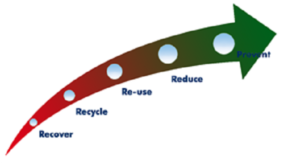 This advice from B&M Waste…
This advice from B&M Waste…
Rather than viewing waste as costly but necessary problem, taking a step back and looking at potential improvements will enhance your organisation’s environmental and financial performance.
Know what waste you generate
It is easy to assume that you produce ‘general’ and ‘recyclable’ waste, but to tailor the right solution, at the right price, you need to understand the actual type, quantity and source of waste generated at your business premises. Whatever the size of your property, take the time to look at the waste going into your general waste containers – you might be surprised at how much, and the type of, recyclable material that is mixed in there.
Embed practical recycling processes
By identifying which areas of your business premises produce what waste, you can modify the waste storage provisions to segregate more recyclate and reduce the more costly general waste collections. Are the bins situated in a practical location? Are they clearly signposted? Is your recyclable waste being cross-contaminated with other materials? Does everyone have a desk bin that makes it too easy to mix the contents? You need to have the right storage facilities available and ensure that all members of staff buy-in to their obligations.
Minimise the amount of waste you generate
Once you have assessed the type, volume and source of the waste streams, you can also find ways to minimise waste. This may involve rolling out a company-wide waste minimisation campaign, for example by encouraging people to print less paper, reuse their coffee cups, and wash out containers to remove food residue.
Speak to an expert
Now that you have garnered a better understanding of your waste, speak to a commercial waste management company who can advise on an effective strategy that is bespoke to your requirements. Perhaps you have enough of a particular commodity to bale the material and generate revenue – such as cardboard, or a compactor could be useful to reduce general waste transport and disposal costs. Companies like B&M Waste Services can use the data you have collated to help determine if this is the case.
Neil Curtis, MD at B&M Waste Services said; “We have significant experience of working in partnership with FMs. We have even devised an innovative system whereby the tenants are responsible for their own waste volumes. We can identify who produces what waste within multi-tenanted locations and allow the FM to apportion service charges appropriately. This gives the FM significant flexibility and transparency in terms of cost and recovery efficiencies.
“It is important to always view the requirements on a site-by-site basis; there is no one size fits all approach. Our expert team will provide a free waste audit and put forward a custom-made no obligation proposal. This is done in line with the Waste Framework Directive, so we always look to identify additional opportunities for source segregation where “Technically, Environmentally and Economically Practicable” (TEEP).”

